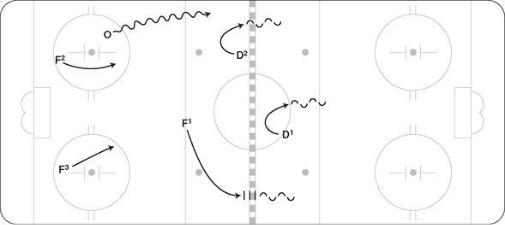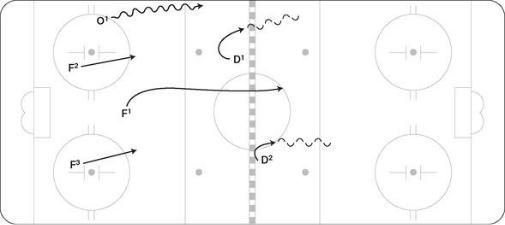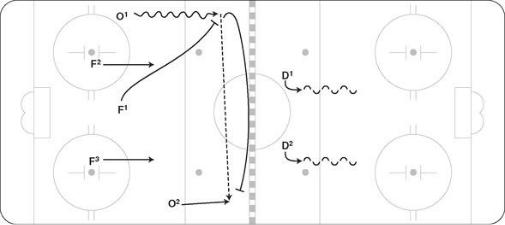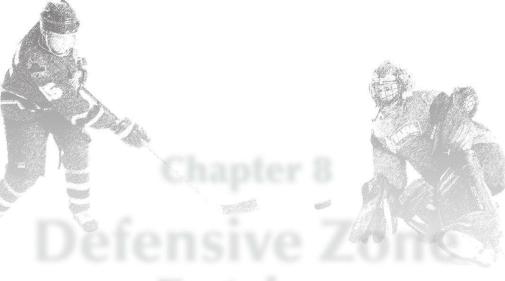
- •Foreword
- •Preface
- •Key to Diagrams
- •Reading Pressure and Options
- •Reacting to Support the Breakout
- •Breakout Plays
- •Control Breakouts
- •Counters
- •Regroups
- •Dump-In Entries
- •Mid-Ice Entries
- •Wide-Lane Drives
- •The Funnel
- •Two-on-One Attacks
- •Two-on-Two Attacks
- •Three-on-Two Attacks
- •Offsides
- •Activating Defense Into Offensive Zone Entries
- •Cycling
- •Playing Behind the Net
- •Stretching the Zone: Low-High Plays
- •Activating Defense in the Offensive Zone
- •Attack Zone Plays
- •Power-Play Breakouts
- •Gaining and Maintaining Possession off the Entry
- •Zone Setup
- •Five-on-Three Power Play
- •Four-on-Three Power Play
- •Forechecking Systems
- •Neutral Zone Forechecking
- •Neutral Zone Forechecking Systems
- •Neutral Zone Backchecking
- •Neutral Zone Backchecking Systems
- •Handling Defensive Zone Entries
- •Defensive Zone Systems
- •Situational Guidelines for Defensive Zone Coverag
- •Face-Offs and Penalty Kills
- •Forechecking and Penalty Kills
- •Pressuring the Entry
- •Defensive Zone Play
- •Three-on-Five Penalty Kill
- •Three-on-Four Penalty Kill
- •Offensive Zone Face-Offs
- •Neutral Zone Face-Offs
- •Defensive Zone Face-Offs
- •Power-Play Face-Offs
- •Penalty-Kill Face-Offs
- •Special Face-Off Situations
- •Managing Staff
- •Dealing With Officials
- •Adjusting Your Playing Strategy
- •Managing Lines
- •Line Changes
- •Handling the Moment
- •Index
- •About the Authors
Neutral Zone Backchecking Systems
There are three backchecking systems that teams may employ: wide-lane lock, midlane backcheck, and hound the puck. Each system is described and discussed in this section, and each has a different emphasis on where the offensive players are confronted and how they are confronted.
Wide-Lane Lock
In this system, the first forward on the backcheck immediately moves to an outside lane. Once the forward gets into the wide lane, he may skate backward or forward but must always be able to see the puck and any opposing skater in that lane. This forward is responsible for any opposition player skating between the dots and the boards on that side. D1 now moves to mid-ice, assuming responsibility for this lane, and D2 takes the strong side where the puck carrier is. Essentially the ice is divided into three parts, with each of these players protecting a zone (figure 7.17). The offensive team will have a difficult time getting across the blue line in possession of the puck with three players protecting the line. All three defensive players (D1, D2, F1) attempt to stand the attack up at the blue line while F2 and F3 continue to pressure from behind the attacking players.
The responsibility of F1 is to prevent any passes to that side and to stay close to his check. It is always best to be deeper than the opponent, which is usually called good defensive side position.
Figure 7.17 Neutral zone backchecking wide-lane lock.

Midlane Backcheck
Once the puck is turned over in this system, the first instinct of the high forward should be to get to mid-ice and come back hard through the center seam. All forwards come back through the middle, allowing the defensemen to play the outside areas. The first forward back protects the defensemen from being beaten inside by always staying between the puck and the net (figure 7.18). Therefore, if a defenseman makes a mistake, the forward is always in a position to cover up. Plus, having the forward in the middle intimidates the puck carrier and forces him to stay wide because of the lack of space inside.
When the first forward comes back through the middle, he should come all the way back to the low slot area and then move out to support the defense. The second and third backchecking forwards should once again come back hard—look around for any late players entering the zone, and stop at the top of the circles in good defensive position.
Figure 7.18 The midlane neutral zone backcheck.

Hound the Puck
This system is the opposite of the midlane backcheck. The first forward “hounds” the puck (backchecks toward the player with the puck) as hard as he can, and if a pass is made, then the forward continues to pressure the puck (figure 7.19). The forwards limit the time and space for the opposing players as they move through the neutral zone and the defense hold inside position—protecting the space between the dots. Coaches who like this system are generally ones who want to have a pressure philosophy and in all areas of the ice want to deny time and space.
The advantage of this system is that the opponent has little time with the puck through the neutral zone if the backchecking forwards are quick and work hard, plus the positioning of the defense is always inside. The disadvantage is that at times there is confusion between the backchecking forwards and the defense as to what to do if the forwards cannot catch the opposition by the blue line or confront the pass quickly enough. A team must develop rules for these two scenarios so there is no confusion when they occur. One rule involves hounding the puck until the red line, where the backchecking forward must then pick a lane to skate into or pick up a man to cover.
Figure 7.19 “Hounding” the puck in the neutral zone backcheck.


Chapter 8
Defensive Zone Entries
The most critical aspect of defensive zone entries is that the defensive players accepting the attack must correctly read the play. For the purposes of this book, defensive zone entries are defined as the moment the attacking team hits the offensive blue line with the puck. Once this happens, the defensive players, which are usually the defensemen and possibly one forward, must scan the rush quickly and identify how many attackers and how many defenders. Because of the dynamic nature of hockey, this read must be done in seconds, and rarely is any situation exactly like another. Once the defenders see the rush clearly, they should
exactly like another. Once the defenders see the rush clearly, they should call out whether it is a two on one, two on two, or three on two and also communicate to any forwards coming back which player to pick up. The forwards coming back must read the rush quickly from the back side and pick up the right players.
If reads are so important, how do coaches improve the players’ ability to identify the rush? Well, there are a couple of ways. First, do read-the-rush drills in practice, where players are faced with different situations; once they play it out, they get feedback from a coach who is off to the side. A simple read-the-rush drill may include a neutral zone regroup where the defenseman must step up, read the rush, close the gap, and make it difficult for the offensive team to gain entry with possession. Another drill starts as a two on two with a backchecker and turns into a three on three, with the coach sending the backchecking and offensive forwards at different intervals.
The second way to help players identify the rush is to review the video and ask what they see and how they would play each situation. Many times while watching video, players will comment that during the game they read that they have less time and space when in fact on the video they see it differently. It is helpful to hear their perspective. Also, during games have one coach on the bench who provides feedback and discusses reads with the players while the game is going on. The best approach is to ask the players, “What did you see on that rush?” and then tell them what you saw. Finally, to clear up any confusion about reads, set a rule for what players should do if they are unsure. The rule should be: hold mid-ice position, take a few more seconds to sort it out, and then when you are sure, move to outside areas to challenge the puck carrier.
